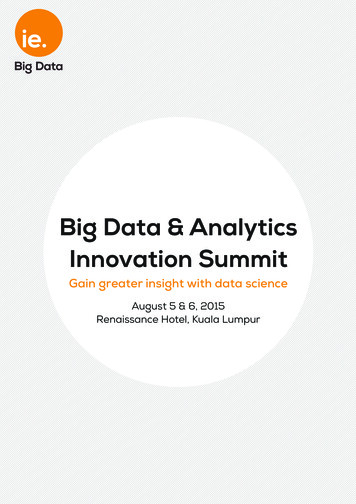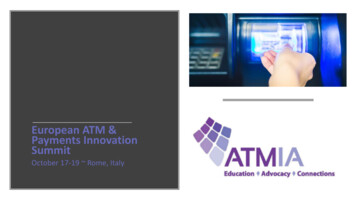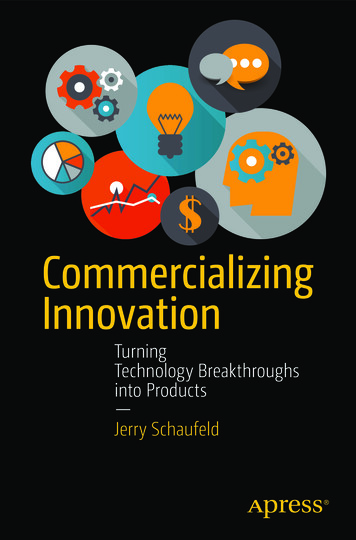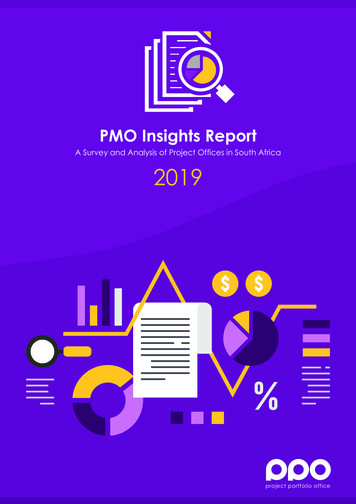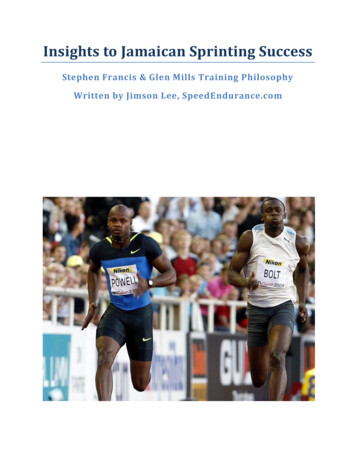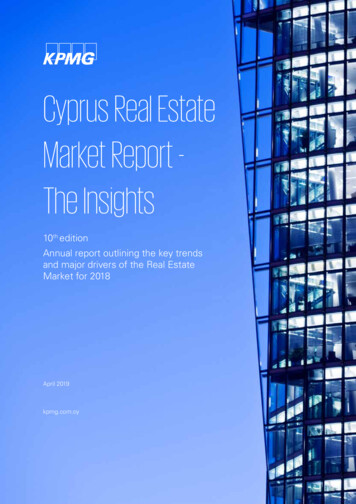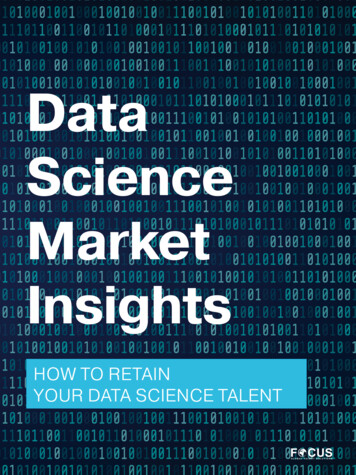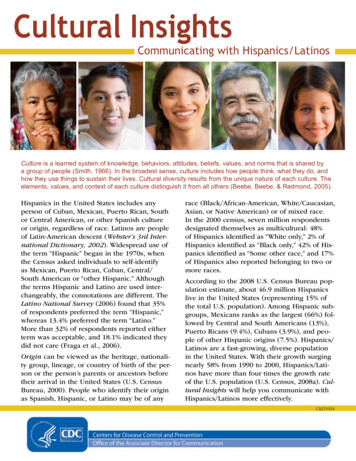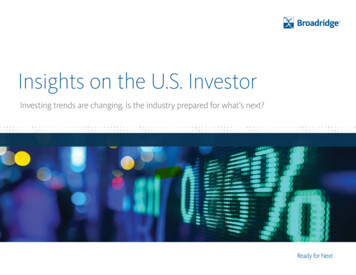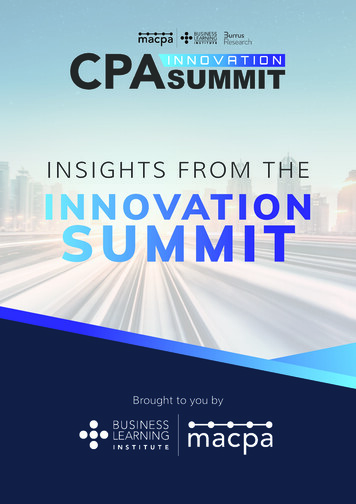
Transcription
Insights from the Innovation SummitBrought to you byMaryland Association of Certified Public AccountantsandThe Business Learning InstituteINSIGHTS FROM THEI N N OVAT I O NSUMMITBrought to you by1
Introduction3Our Partners4Our speakers served as conversation starters, tackling these compellingquestions 5In the live chat, we asked attendees 7In the live chat, we asked attendees 8In the live chat, we asked attendees 9Moving from “essential” to “indispensable”11The way we can workBreakout Room #1: Digital Transformation13Breakout Room #2: Rebranding CPAs as trusted strategist14Breakout Room #3: Being Indispensable15The skills we can perfect16Breakout Room #4: Being Value-Added Advisors17Breakout Room #5: Working Alongside Automation18Breakout Room #6: Continuous Process Improvement19The tools we can harness20Breakout Room #7: Advancements in Cloud Computing21Breakout Room #8: Artificial Intelligence / Machine Learning22Breakout Room #9: Big Data and Analytics23Next Steps?21224
IntroductionFacing inevitable changes can be both daunting and invigorating. The lastinstallation of the CPA Innovation Summit focused on anticipation andreimagination to put the CPA profession on an exciting path forward.This time, we focused on moving from essential to indispensable.Collectively travelling to and from the future, we’ve come up with buildingblocks serving to begin our profession’s path toward a bright future.Jumping off the identified seeds of future opportunities and impactsof the pandemic, CPA Practice Advisor Editor Gail Perry led panelistsand attendees in a conversation that looked from present to future.We reflected upon lessons learned in 2020 about being “essential” andits impact on future work and perspective. Then, we took a trip to thefuture with Dan Hood, editor of Accounting Today, who led panelistsand attendees in envisioning what work and life will be like in 2030 andpossible critical decisions made along the way that positioned us to beindispensable. The goal of taking on both perspectives is to drive formationof the foundation of our collective path forward in order to break throughthe fog of uncertainty. We also aim to motivate movement towards ourindispensable future through analytical conversations while consideringour work-life balance.Among the 167 attendees and eight panelists, collective insights of 1,112chat messages were exchanged. Attendees then moved into live video chatbreakout discussions to dive even deeper into subtopics under the threeoverarching themes: The Way We Can Work, The Skills We Can Perfect,and The Tools We Can Harness. Attendees answered strategic questionslooking at how we might practically achieve our profession’s biggestopportunities.The following pages present the culmination of attendees’ insights anddetail the various ways in which they have helped co-create this e-book.Thank you all for participating enthusiastically and offering a multitude ofinsights contributing to our profession’s collective success.3
Our partnersThank you to our preferred providers in the accounting and technology ecosystem,who are partnering with us to imagine the possibilities and co-create the future of theprofession. Together these companies form the Accounting Ecosystem providers whoare helping the finance and accounting system be #FutureReady, aware, predictive, andadaptive.#FutureReady ResourcesStrategic foresight:What can we be certain about?On Oct. 2, 2020 we started on this journey to reimagine our post-pandemic future. Wegathered our community with global futurist Daniel Burrus and accounting influencerTom Hood, CPA, CITP, CGMA, to talk about the leading trends facing the professionand the Burrus “Science of Certainty,” and how he uses “Hard Trends” to predict futuretrends. In that session with more than 600 attendees, we discussed how much thingshave accelerated since the pandemic began in March 2020 and what opportunities theycould now see and are most excited about. The results and report are in this link:Results & report4
Our speakers served asconversation starters,tackling these compellingquestions:From Present to the Future: Where are we now,what did you learn, and what’s your future view?SPEAKERS:5Gail Perry,Editor, CPA Practice AdvisorAnoop Mehta,CPA, President, SSAISydney Garmong,CPA Office Managing Partner,Crowe, LLPRusty Davis,CPA, Principal, Davis &Associates
From Future to Present: Where will you be in 10years, a “back-to-the-future” view?SPEAKERS:6Dan Hood,Editor, Accounting TodayChris Benson,CPA, Principal, L. K. Benson &CompanyAvonette Blanding,CPA, CFO, Maritime AppliedPhysicsJessica McClain,CPA, Controller, Brand USA
In the live chat, we asked attendees What have been some unexpected results that came out of the pandemic?andWhat do you think will be the best and longest impact of the pandemic?Comparing these two questions, we saw a lot of similarities between what CPAs havenoticed today in our work, and what we expect will remain the same in the future (andthus has been changed forever!)Here’s what the community said:UnexpectedresultsLongest impactMore planningMore creativityAbility to work from afar/ abroadMore productivityMore casual and friendlyrelationsNormalizing remote workMore personal timeMore comfort at homeMore time at homeSave money7More flexibilityGoing globalBetter work-life balanceCloser and deeper connectionsExercise and healthy eatingNo commuteMore accessibilityEnvironmentallyfriendlyAutomationMore tech savvyHuman touch, more caring and empathyHybrid, flexible workmodelAdaptabilityConvenience
In the live chat, we asked attendees What will you take with you and do more of in the future?Here’s what the community said:“Flexibility is the key. I will choose to work from home more.”– Mary Aldrich-Knight“More casual, more human, more empathy for others, more connections.”– Tom Hood“Traditions and practices we were ‘chained to’ will be broken, and that flexibility will bekey to success.”– Stacey Milbourne“The pandemic has introduced a human element that was not there before. I LOVE thisand hope it doesn’t go away.”– Sona Akmakjian“Maintaining long-distance relationships– Zooms with long-distance family and friends.” – Jan Williams“More cloud and automation to allow focus on human interaction and higher levelservices.”– Tom Hood“Future takeaways: Helping the young adults be prepared for tough times. The kids of9-11 and the housing crash have different perspectives than other generations, butlearned lessons I’d love to hear how they are coping with these days.”– Susan Jeter8
In the live chat, we asked attendees What will you be doing in 10 years, if you can make as much change in the next 10years as you made in the last eight months?Here’s what the community said:“Retired, but looking for waysto continue to contribute to theprofession.”“Technology will changeeverything and the professionwill be digitized.”“Take over the world.”“More data analytics and techapplication along with more‘success skills’ (not soft skills).”“Working to improve outcomesin my community.”“Living in my purpose.”9“Helping others live betterlives financially.”“Leverage the virtual platformto balance work and play.”“Probably doing what I likedoing — helping clients and(hopefully!) getting paid forit. Helping my friends andneighbors is fulfilling andgetting paid is a great benefit,too.”
What future opportunities are youmost excited about?Below is a mindmap of the biggest themes shared by attendees. Being indispensableGeographic barriers removedDigital TransformationChanges in generational leadershipRemote-first workforce and cultureExpanded customer base Greater diversity, equity, and inclusionRebranding CPAs as trusted strategistsExpanded talent poolBusiness model transformationValue pricing and subscription modelsThe way wecan work:The skillswe canperfect: 10AnticipationTrendspottingStrategic ThinkingCollaborationBeing value-added advisorsWorking alongside automationCreation of new servicesContinuous Process improvementAccelerated LearningBuilding a culture of significanceThe toolswe canharness: Advancements in cloud computingAI/ML capabilitiesRPA - Automated bookkeepingBig data and analytics toolsNew virtual platforms andcollaboration tools Enhanced online payments Online & Blended Learning Blockchain
Moving from “essential”to “indispensable”After the two panel conversations, attendees were split into nine breakout rooms. There,attendees addressed how to approach the process of moving from being essential tobeing indispensable, and the following pages reflect their brainstormed thoughts andapproaches.The way we can workBreakout Room #1: Digital transformationBreakout Room #2: Rebranding CPAs as trusted strategistBreakout Room #3: Being indispensableThe skills we can perfectBreakout Room #4: Being value-added advisorsBreakout Room #5: Working alongside automationBreakout Room #6: Continuous process improvementThe tools we can harnessBreakout Room #7: Advancements in cloud computingBreakout Room #8: Artificial intelligence / machine learningBreakout Room #9: Big Data and analytics11
The way we can work12
Breakout Room #1:Digital transformationFacilitator(s):Safesend - Mike CuffleSECU- Irwin WeinsteinImagined outcomes and results:Digital transformation is happening right before our eyes, and it is pivotal nowmore than ever to ride the wave of discovery and change. In the coming years, weanticipate more successful hybrid work environments, catering toward the virtualwhile also having more flexibility back “in the office.” Firm digital transformationwill make us more productive, less stressed, and more profitable as we improvecapacity.Barriers to overcome: How might we introduce new technology to clients and staff? How might we curve skepticism? How might we better listen to one another? How might we aid those who are less comfortable with tech? How might we create technology roadmaps for staff?How do we accomplish / implement this? Adopt suitable technologies. Be curious and willing to learn. Listen and educate.13
Breakout Room #2:Rebranding CPAs as trusted strategistFacilitator(s):cpa.com- Brian SietCPA Charge - Amy MannImagined outcomes and results:CPAs work in the best interest of our clients; it is imperative that we work towarddeveloping strategies to rebrand and, in turn, build trust. Machines produceresults, but humans provide reasoned judgment, experience, and insights. Intoday’s financial and social climate, we must constantly shift our focus to thefuture in order to provide clients with the most valuable insights.Barriers to overcome: How might we create attitudes working toward change management? How might we avoid simply going back to the way it “used to be”? How might we encourage advising? How might we rebuild business culture to be more collaborative? How might we reinvent ourselves to be more forward-looking?How do we accomplish / implement this? See where the market is heading, the industry trajectory, make a plan, implementit, measure it. Use case studies, share success stories. You have to sell the benefits to being a trusted strategist. There will always besome people who don’t want that kind of work, but there are others who mightjust not understand what it means or what it will look like.14
Breakout Room #3:Being indispensableFacilitator(s):ADP- Laura JansenThomson Reuters- Will HillImagined outcomes and results:Acknowledgement and appreciation of hard work are always validating to thosededicated in their field. We must develop tools and strategies to ensure thatour work is seen by clients as indispensable in order to retain both employeesand clients. We must shift from a compliance role to an advisory role. We mustoperate through the lens of the customer and commit to being as dedicated toreaching their goals as they are. In supporting our clients, we increase our value.Barriers to overcome: How might we combat fear? How might we create a business culture that is more open?How do we accomplish / implement this? Looking at what we will risk if we do not make the investment. The first step is to know yourself and if you are indeed risk-averse.15
The skills we can perfect16
Breakout Room #4:Being value-added advisorsFacilitator(s):Sage - Ed KlessXero - Michael SobyImagines outcomes and results:To continue as value added advisors for our clients, we need to adapt to bothchanges and clients through adopting positive outlooks and continual learning.By working toward the following, we imagine more satisfaction in our work andmore client recognition of worth in services provided by us, as well as expansionand growth in our own business and in the industry.Barriers to overcome: How might we adapt to changes and clients in a positive way?How do we accomplish / implement this? More quality conversations with clients. Openness to learning from others in the industry through creating a greatprofessional network.17
Breakout Room #5:Working alongside automationFacilitator(s):Avalara - Sona AkmakjianAccountants World- Div BhansaliImagined outcomes and results:Working alongside automation is an inevitable part of the industry’s evolution.We envision that by embracing this reality and the following answers posedby attendees, we will see three dimensional growth — new service areas andvalue, increased efficiency, and increased quality and satisfaction in work forboth clients and employees. As well as cultivation of a better work environment,we will be quicker in adapting to change with consideration of work/life balance.Accuracy and scalability of services will improve as a result of automationintegration.Barriers to overcome: How might we see changes as an opportunity? How might we use leaders to prepare everyone for changes? How might we cultivate an environment of adaptability and understanding? How might we inspire people to embrace change?How do we accomplish / implement this? Shifting resources into more exciting areas, such as data, robotics, and planning. Positing automation as an exciting opportunity. Proving that automation works, seeing value in the solutions and how it willimprove results. Hybrid approach of integrating people issues and technical issues by focusing onpeople first and then using technology solutions. Recognising that automation will allow for us to focus on people.18
Breakout Room #6:Continuous process improvementFacilitator(s):Prophix- Wayne SlaterDext- Keith BatemanImagined outcomes and results:Continuous process improvement is what propels us forward in providingquality services to our clients. Through addressing the following, we envisionimprovement made by finding solutions that achieves the intended results insolving problems. Along with utilisation of new technology to create efficienciesin not only the process, but our teams as well thus increasing morale andproductivity.Barriers to overcome: How might we inspire new ways of thinking? How might we encourage flexibility in people’s mindsets? How might we incorporate new voices and ideas in the evolution of thisprofession? How might we forge trusting relationships?How do we accomplish / implement this? Thinking outside the box and reinventing the way processes “have always beendone.” Keeping an open mind and asking for feedback on process changes. Taking advantage of technology as much as possible. Providing support and an environment for innovators and creatives to thrivewithin our organisations.19
The tools we can harness20
Breakout Room #7:Advancements in cloud computingFacilitator(s):Vic.AI - Todd RobinsonIntuit- Jasen SteinImagined outcomes and results:With advancements in cloud computing, we expect a more seamless and efficienttechnology support that will support our businesses in the future. When we allowtechnology to be more efficient, we also allow ourselves to revert back to being reliableand trusted advisors. By keeping the following in mind, it will save us a lot of time, grantus superiority in security, and provide us with the best ability to scale.Barriers to overcome: How might we maintain the ability to integrate with other applications? How might we devote the right amount of time in order to investigate andimplement changes in the cloud?How might we accomplish/ implement this? Find out where your vendors are in the SOC compliance model. Partner with the right tech vendors that will support you and your services best.21
Breakout Room #8:Artificial intelligence / machine learningFacilitator(s):MindBridge- John ColthartBotkeeper- Enrico PalmerinoImagined outcomes and results:Being able to focus on the type of work that is the most mentally stimulating,what people need the most, and what will make the biggest difference are thekey ingredients to a successful future with artificial intelligence. By focusing onthese ideas, along with the following points, we foresee that we will be able toprovide added value to our clients.Barriers to overcome: How might we bridge the generational gap? How might we overcome the fear of change? How might we learn to adapt quickly?How will we accomplish/ implement this? It is okay to change. It is okay to fail. Curious in the hiring process how to identify people who have a mindset of beingadaptable (how to identify those traits in people). Push non-valued work off to the “machine.” Enabling the existing team to enact change. If you want to change / evolve, bring in people who are different than the currentculture. Communicate the value; permission to fail. Technology. Technology is also changing as a response to societal shifts. An interestingfeedback loop (because tech also catalyzes societal shift) . Giving employees back time — to learn something new or work on somethingthey don’t usually have time for. Collaboration.22
Breakout Room #9:Big Data and analyticsFacilitator(s):Engineered Tax Services- Heidi HendersonByteChek- Jeff CookImagined outcomes and results:Big data and analytics will be able to predict future outcomes that we can use tohave more relevant and customized products that better suit our clients needs.In order to do this, we must have better information for strategic planning, betterpreparation for lending and equity requests, as well as better communicationthrough alternative methods of presentation. From this, and from the following,we will be able to provide more valuable information for customers and clients.Barriers to overcome: How might we find the right talent/professionals who know how to use thesetools and get the most out of them? How might we make sure everyone is on board and comfortable with newtechnology and the information it provides? How might we overcome the fear that CPA will be less important, have less work,etc.? How might we track the cost of training and/or the hiring of a skilled employee? How might we improve our and Senior Management’s knowledge of thistechnology? How might we dispel the belief that jobs are being eliminated, instead of upskilled? How might we find ways to be creative while using data and analytics? How might we make time or create a position with the time to spend to learn andpotentially fail fast? How might we ensure that we have a high level management champion to keepthe project on track? How might we confidently take inventory of current organization data and takethose first steps?How might we accomplish / implement this? In the earlier session, there were several comments about changing/updating theaccounting curriculum at universities. I agree. We also need to educate ourselvesand clients.23
Next Steps?How to engage your people with lessons you learned from Innovation Summit:0102You can ask yourself how this topic could be relevant to your own practice.If you are unfamiliar with the given topic, a good p
installation of the CPA Innovation Summit focused on anticipation and reimagination to put the CPA profession on an exciting path forward. This time, we focused on moving from essential to indispensable. . Enhanced online
